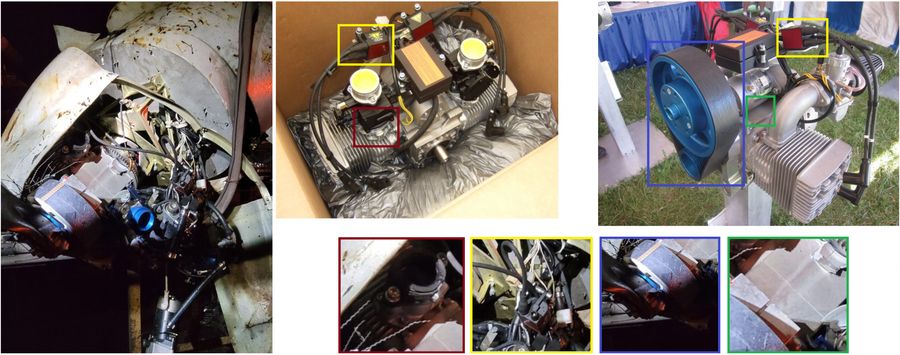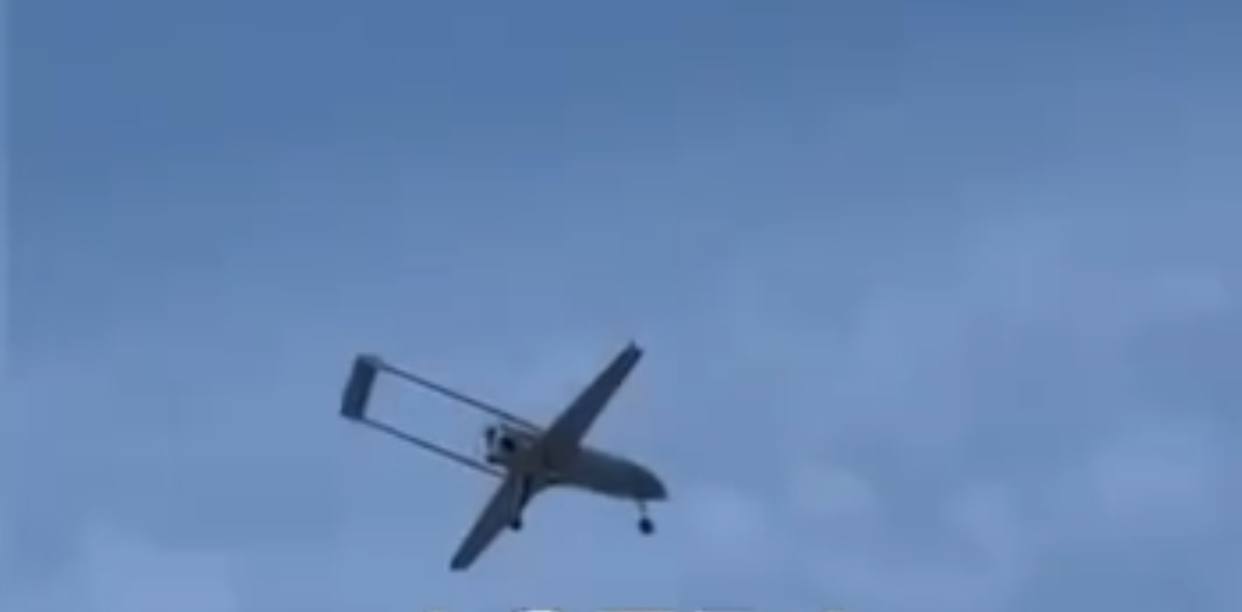Since the start of 2024, Ukraine has operationally mass-deployed its new indigenous "Liutyi" one-way attack long-range unmanned aircraft, conducting precise strikes deep inside Russia, crippling more than a dozen of Russia's high-value industrial assets, including refineries, oil depots, and factories across an 800km radius of Ukraine's borders.
Liutyi is just one among multiple long-range suicide drones developed or repurposed by Ukraine, but its performance has distinguished it from other models. The ongoing three-month campaign to undermine Moscow's fuel production capacity has been successful, with about 7% of Russia's refining capacity idling in the first quarter of 2024.

The Ukrainian military news portal Militarnyi compiled detailed information on the Liutyi drone, a key asset for Ukrainian intelligence agencies in their latest deep rear bombing campaign against Russia. Here is what we know about the Liutyi, based on Militarnyi's report and several other sources.
Development and price tag
Ukrainian defense conglomerate Ukroboronprom publicly announced
the development of the Liutyi in October 2022. The firm said it intended to create an attack drone weighing over 200 kg, capable of carrying a 75 kg warhead at a distance of more than 1,000 km. It is the first Ukrainian system analogous to Iran's Shahed-136 suicide drones in terms of payload, range, and autonomous attack ability.
The new drone was a response to the requirements laid out in early August by then-Commander-in-Chief of the Ukrainian Armed Forces, Valerii Zaluzhnyi. When unveiling an element of the Liutyi's fuselage, Ukroboronprom included the biblical inscription "Az Vozdam" (Old Slavonic for "I will repay," referring to the Bible's Romans 12:19) – a sign indicating forthcoming retaliatory strikes against Russian assets. The name Lityi, in turn, means fierce/furious or February in Ukrainian.

- In December 2022, Ukroboronprom said a combat drone it was developing had passed “a number of stages of successful testing” and was moving to the stage of testing under electronic warfare.
- A year later, on 16 November 2023, the Minister of Strategic Industries Oleksandr Kamyshin stated that Ukraine had entered into mass production of strike drones analogous to Iran's Shahed-136 loitering munitions. Referring to what was known as the "Ukrainian Shahed," Kamyshin said Ukraine was now manufacturing "tens per month" but did not disclose the name. The Ukroboronprom CEO confirmed the beginning of the drone's mass production.
- In June 2023, Ukroboronprom announced the successful completion of a 1,000 km trial for the drone. Ukrainska Pravda speculated, referring to its sources, that the effective employment of the Ukroboronprom’s UAV occurred on 3 May 2023, when an attack caused a fire at a Russian oil depot in Volna settlement on Russia’s Taman peninsula next to Crimea, some 250 kilometers from the frontline.
Militarnyi has learned from its own sources that the Liutyi's approximate cost is twice as much as the previous Bober ("Beaver")
attack drone. The latter is known to have been purchased by Serhii Prytula's Foundation for 4 million UAH per unit (about $100,000).
Project “Black Box”: How Ukrainians unknowingly crowdfunded deadly new drone fleet
Liutyi's design and specifications
The Liutyi represents a step up in Ukrainian drone technology and offensive reach. It is an unmanned low-wing monoplane powered by a gasoline engine and equipped with an advanced satellite-aided inertial guidance system for autonomous navigation over long distances.
In the initial stages of the Liutiy drone project, there were claims that the drone would serve as a versatile platform, but it's unclear from publicly available information whether this goal was achieved, or if the Liutiy was solely deployed as a one-time kamikaze drone, Defense Express says.
Based on open information and multiple photos of the wreckage shared by Russians from the first three months of the Liutyi's deployment in 2024, its design and capabilities can be analyzed in depth. The unmanned low-wing monoplane has a 6.7-meter wingspan and 4.4-meter length, with a maximum takeoff weight between 250-300 kg. The drone boasts aerodynamics optimized for extended range.

Its pusher configuration sees a gasoline piston engine with a three-blade propeller installed in the rear fuselage. This weight distribution likely allows for a heavy explosive warhead in the nose. The drone has a fixed undercarriage for takeoffs and landings from roads or runways.
The sleek aerodynamic fuselage with winglets aids in maximizing range. It mounts a pitot tube under the nose for measuring airspeed and altitude. The composite fuselage uses fiberglass, epoxy resin, metal mesh, and wood for stiffness.
3. Videos of attacks provide additional details. Most of the design features seen in the model are present. In addition, there appears to be winglets and a long pitot tube. There may be a pod under the nose (perhaps a camera). pic.twitter.com/Mkf480bzVq
— DanielR (@DanielR33187703) March 16, 2024
To ease logistics, the Liutyi breaks down into major components - the nose section with the warhead, fuel tank, and engine; removable wings; and empennage attaching near the engine nacelles.
The wreckage of the Ukrainian drone's engine shares design similarities with the German Hirth F-23 50hp aviation engine, estimated to cost around $5,000. Militarnyi notes that distinctive cylinder heads, mounts, and electrical features match this commercial piston engine model.

Warhead and guidance
The Liutyi's thick-walled steel warhead casing weighs approximately 50 kg, according to Russian sources, down from Ukroboronprom's initial 75 kg claim, but this precision-guided munition has proved more than adequate to wreak havoc on Russian infrastructure. Its bladed exterior suggests enhanced forced fragmentation over a penetrating shaped charge.

Other features like attachment rings point to it being crane-loaded into the drone's nose section right before launch, implying a modular design. However, the initiation system seems deficient based on the number of intact unexploded warheads found.
The most significant advancement is Liutyi's improved inertial guidance aided by satellite signals. All previous Ukrainian strike drones relied solely on this traditional system susceptible to jamming and navigation drift.
By enhancing the satellite antenna's shielding and likely adding backup data links, the Liutyi displayed pinpoint accuracy in striking exact components from over 1000 km away during night bombardment runs into Russia.
Ukraine starts mass production of 750 km range “kamikaze” drones
The drone platform's modular design allows it to be broken down for easier transportation and logistics. Its fairly compact size, when disassembled, permits launch from improvised sites like roads, rather than requiring dedicated airstrips. This operational flexibility enhances survivability and complicates Russian countermeasures.
Drone strikes crippled the Yakovlev Explosives Plant in Dzerzhinsk, Nizhny Novgorod Oblast, – a producer of explosive materials for Russian munitions. Other drones hit the Lipetsk Metallurgical Combine, disrupting some steel supplies.

Militarnyi believes the warhead's bladed casing design, rather than a penetrating shaped charge, indicates an intent to inflict widespread fragmentation damage ideal for wrecking machinery and inflicting casualties in the open.
Ukrainian Cobra fixed-wing suicide drone achieves rapid production
Strategic bombing campaign with Liutyis
Since early 2024, flights of 2-6 Liutyis executed over a dozen strikes on strategic Russian sites up to 800 km inside Russia's territory. Nine oil refineries had specific refining units accurately struck, while the Novolipetsk Steel Plant and Nizhny Novgorod explosives factory were also hit.
Two Ukrainian agencies – the Defense Intelligence Directorate (HUR) and the SBU security service – are coordinating these drone operations, according to Ukrainska Pravda sources. SBU markings on one warhead indicate its special operations personnel have access to the drones.
The long reach has given Ukraine the ability to degrade Russia's strategic depth and industrial potential, while Liutyi's ongoing mass production will only sustain and intensify the bombardment.
Below are several drone attacks on Russia in the first three months of this year. While not all assaults necessarily utilized the Liutyi, video evidence from some daytime attacks clearly shows the Liutyi in action:
- On 23 March, a fire broke out at the Novokuibyshevsk oil refinery in Russia’s Samara Oblast following a suspected drone strike.
- FT claimed that the US warned Ukraine against continuing drone strikes on Russia’s energy infrastructure, but Ukraine denied the claim, with the next attack taking place the next day.
- On 17 March, drones struck the Slavyansk oil refinery in Russia’s Krasnodar Krai.
- On 16 March, drones hit three oil refineries in Russia’s Samara Oblast.
- On 15 March, suicide drones attacked an oil refinery in Russia’s Kaluga oblast.
- On 13 March, drones hit an oil refinery in Ryazan.
- On 12 March, Ukraine carried out a coordinated drone offensive, hitting and damaging at least two Russian oil assets – a refinery in Nizhny Novgorod Oblast and a fuel depot in Oryol.
- On 6 March, an oil depot in Kursk came under drone attack.
- On 14 February, a Kursk oil depot was ablaze after a drone strike.
- On 9 February, kamikaze drones targeted oil facilities in two Russian regions, hitting the Ilsky and Afipsky oil refineries in the Krasnodar region and an oil depot in the Oryol region, causing a severe fire at the Ilsky refinery and damaging a primary processing unit valued.
- On 3 February, residents of Volgograd, Russia, reported two explosions, with the Governor stating that Russian air defense units allegedly intercepted drones targeting an oil refinery.
- A vacuum distillation column at an oil refinery caught fire in Russia’s Tuapse City overnight on 25 January.
- On 18 January, Ukrainian drones attacked an oil depot in the Russian city of Saint Petersburg.
- On 31 January, a drone hit an oil refinery in St. Petersburg.
- On 18 January, Ukrainian drones attacked an oil depot in the Russian city of Saint Petersburg.
Read also:
- Ukraine to boost domestic drone output to tens of thousands a month, minister says
- “Army of Drones” UAVs responsible for over 35% of Russian tank losses in October
- Ukroboronprom: Ukraine’s “kamikaze” drones with 1,000 km combat radius in mass production
- Project “Black Box”: How Ukrainians unknowingly crowdfunded deadly new drone fleet
- Successful use of domestic drone with 1,000 km range reported by Ukroboronprom
- Ukrainian 1000-km range suicide drone passes number of tests
- Ukraine’s state weapons concern announces suicide drone project


